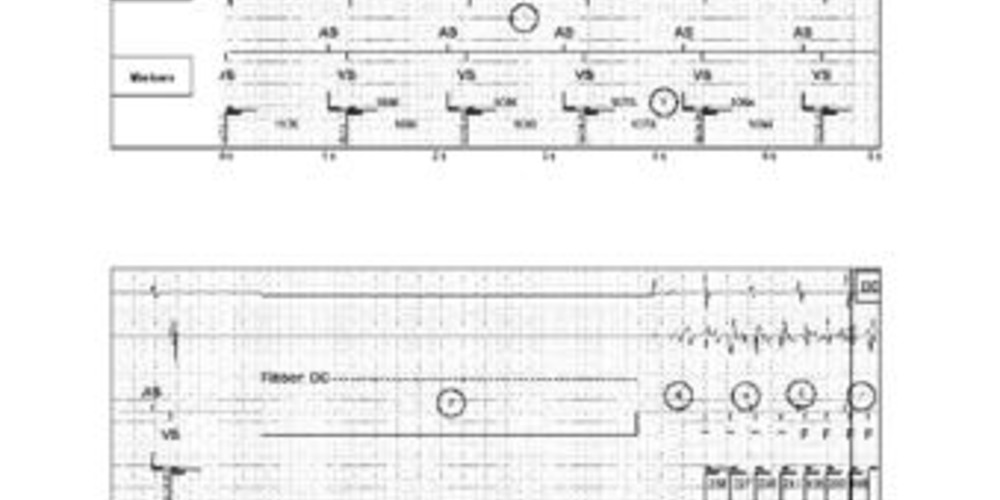Induction of ventricular fibrillation by direct current
This 67-year-old man, who presented with an ischemic cardiomyopathy and 20% left ventricular ejection fraction (LVEF), underwent implantation of an AnalyST Accel dual chamber ICD for a primary prevention indication; ventricular fibrillation (VF) was induced at the end of the implantation procedure.
Main device programming (during the induction procedure)
- Single VF zone
- 8 cycles in the VF zone were needed for the diagnosis
- Sensitivity programmed at 1 mV
- First shock at 25 J, second shock at 36 J (maximum strength). The maximum strength of an ICD can be identified from the model number. For instance, on the AnalyST Accel DR 2219-36 DAI, the number 36 indicates the device’s strongest shock capacity.

The calibration shown on the tracing enables the measure of the various signals’ amplitudes (atrial autogain = 1.8 mm/mV, ventricular autogain = 0.6 mm/mV); the measurements can be facilitated by changing the gain to 1 mm/mV. The 2 ampli channels, which sense A and V, display the filtered signal that are used by the ICD for its analysis; both channels are available in nominal format. Markers and intervals can also be displayed.
- Sinus rhythm (AS-VS);
- The atrial and ventricular refractory periods can be viewed on this tracing; the thick lines correspond to the blanking periods, the thin lines show the refractory periods;
- Induction of VF by delivery of direct current (DC) for 3 sec;
- A 600-ms blanking period follows the induction, during which no sensing is possible;
- Ventricular arrhythmia; the first 4 cycles are unclassified (-); the programmed rates allow a classification of the cycles as a function of the instantaneous RR intervals and of the average of the last 4 intervals. For the induction procedure, a single VF zone was programmed. In the beginning of the episode, the instantaneous intervals were in the VF zone; however, the averaged intervals were in the sinus zone, as the average of the cycles had not reached the VF zone. Since the device interpreted this as a transitional rhythm, the intervals were not classified;
- First interval classified in the VF zone (F); the instantaneous and averaged intervals are concordant;
- At the third cycle in the VF zone (the fourth in other models), the programmable pacing mode during the episode switched to DDI;
- VF episode detected after 8 ventricular cycles in the VF zone with trigger of the EGM recording (Trigger);
- Charge of the capacitors (*); confirmation of the arrhythmia during the charge marked by an underscored F;
- End of charge;
- In order for the shock to be delivered, 1) the charge must have ended, 2) the arrhythmia must have been reconfirmed, requiring ≥6 fast cycles, which are usually detected during the charge, except when it is very short, 3) the sensed event to which the shock is synchronized cannot be the one following the end of the charge, explaining why, in this example, the shock occurs on the second cycle following the end of the charge, 4) the instantaneous and mean intervals of the sensed event to which the shock is synchronized cannot be sinus (no shock is delivered on a long cycle);
- 25 J shock (HV = High Voltage) synchronized to the R wave;
- 1 sec blanking after the shock, during which no sensing is possible;
- Termination of the arrhythmia; after 3 VP cycles (programmable parameter), the device diagnoses the return to sinus rhythm and switches to post-shock DDD mode for a programmable duration (nominal = 30 sec) before returning to the programmed permanent pacing mode.







The induction of VF at the end of an implant procedure has 3 main objectives: 1) verify the integrity of the defibrillation circuit and the connection between lead(s) and pulse generator; 2) verify the proper detection of VF by the device; the tracings must be scrutinized meticulously in search of sensing failure; 3) verify that VF has been cleanly terminated by the ICD shock. The actual defibrillation threshold (DFT) is rarely measured, as most operators simply verify the efficacy of defibrillation with a sufficient margin, i.e. ≥10 J, between the tested and the highest programmable value.
In this patient 1) the measured shock impedance was 59 Ohms, a normal value for a single coil lead, 2) VF was flawlessly detected throughout the episode despite wide variations in the ventricular EGM amplitude, 3) a successful 25-J shock offered a wide enough safety margin compared to the maximum capability of the ICD. Therefore, the 3 objectives were verified.